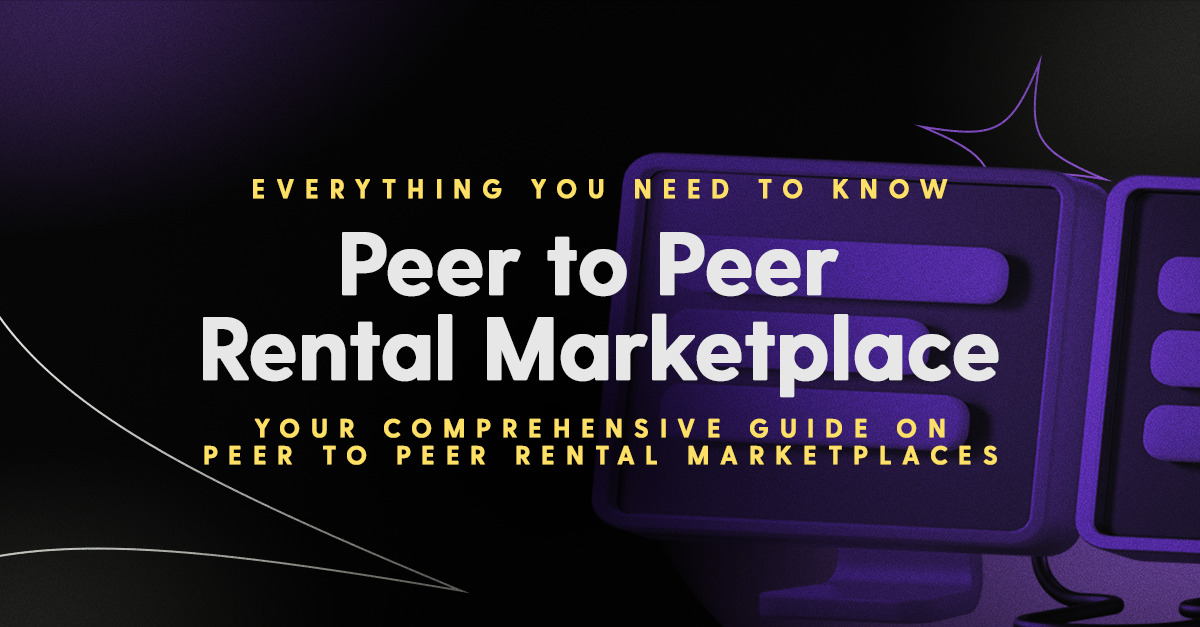Peer to peer rental marketplaces are a type of peer to peer (p2p) marketplace.
Over the last 10 years peer to peer rental marketplace have seen massive growth due to the rise in the sharing economy, changing consumer preferences towards experiences over ownership, government initiatives and advances in technology.
Whilst platforms like Airbnb, Vrbo, Turo and others, paved the way for consumers to realize the value of their under-utilized assets, more and more niche rental marketplaces are springing reshaping industries and redefining tradition.
In this article, we will give you a comprehensive overview of peer to peer rental marketplaces and how you can build, launch and scale your own p2p rental marketplace!
What is a peer to peer rental marketplace?
Peer to peer rental marketplaces are a type of online marketplace that connect property providers with people who want to rent their property. Property providers can display their property on the marketplace as property listings. Renters can then visit the marketplace website and book to use the property for specific date ranges.
The most widely known example of a peer to peer rental marketplace is Airbnb which allows property owners to rent their homes to people looking for short term rentals. However, property does not need to be homes, it can be anything such as equipment, vehicles, artwork and so on.
Examples of peer to peer rental marketplaces
We have already seen that Airbnb is a peer to peer rental marketplace. There are however, many different examples of p2p rental marketplaces. Let’s take a look at some of the lesser known ones such as:
Vrbo, a p2p marketplace for vacation rentals
Vrbo is a peer to peer rental marketplace that connects property owners (hosts) with customers (guests) in search of short term vacation rentals.
The company was founded in 1995 and is focused on helping family and friends take vacations together in high end vacation rentals.
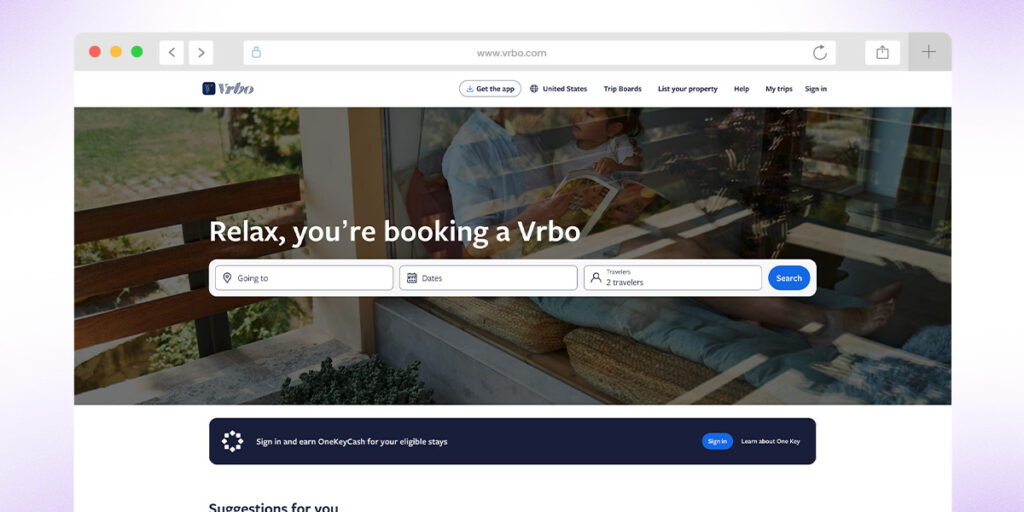
For more information on how Vrbo was built read how to build a website like Vrbo.
Turo, a p2p rental marketplace for vehicles
Turo is a peer to peer car-sharing marketplace. The platform connects private car owners with individuals looking to rent out their cars. Renters are able to visit Turo, browse lists of cars and then book them for specific dates.
Originally founded in 2010 under the name RelayRides, the company rebranded with the name Turo in 2015.
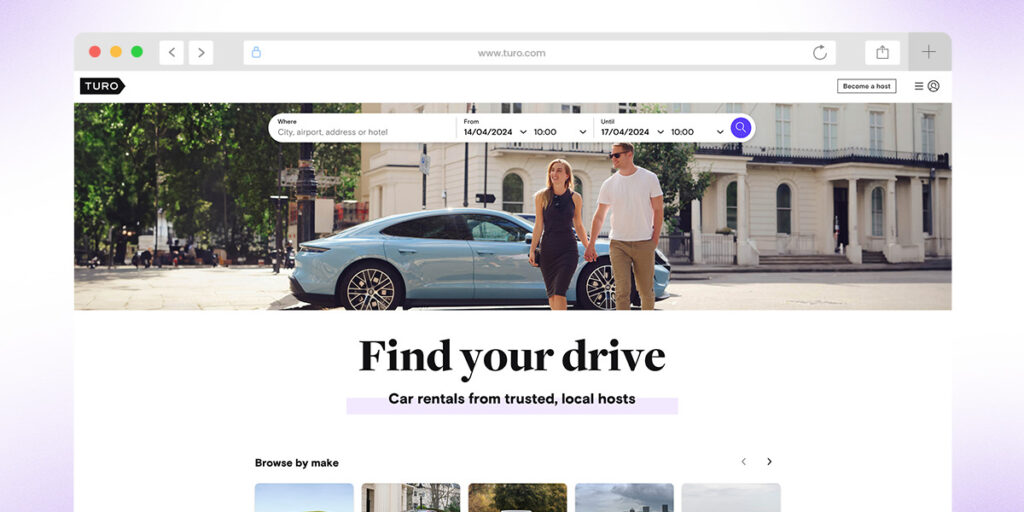
For more information on how Turo was built read how to build a website like Turo.
PeerSpace, a p2p rental marketplace for space
Peerspace was founded in 2014 as a peer to peer rental marketplace that connects individuals and businesses with unique spaces for various events and activities.
Property providers can list spaces on PeerSpace and individuals and businesses can visit PeerSpace to discover and book spaces for events such as meetings, photo shoots, parties, workshops, and more.
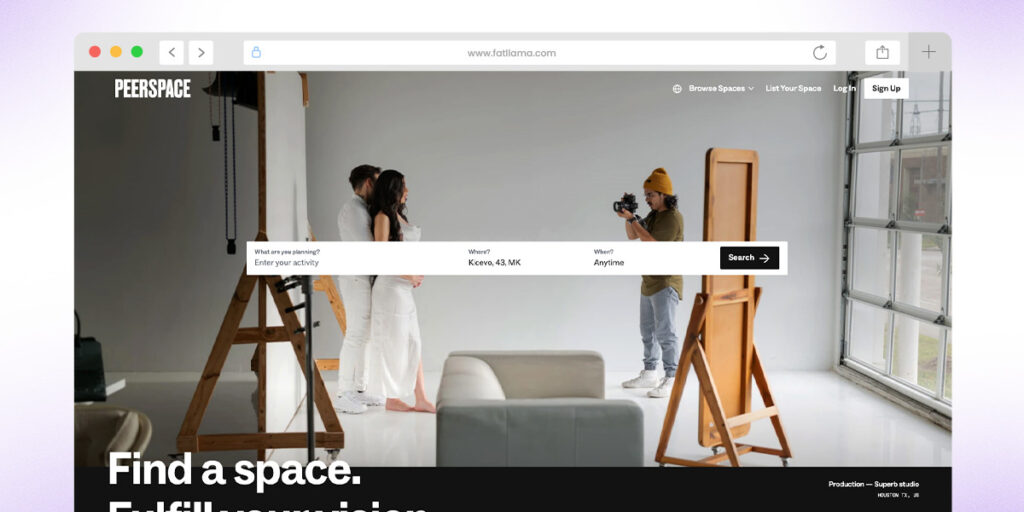
For more information on how PeerSpace was built read, how to build a website like PeerSpace.
Fat Llama, a p2p rental marketplace for everything
Founded in 2016, Fat Llama is a peer-to-peer rental marketplace that enables individuals to rent out their belongings to others in their local area.
Property owners can login to Fat Llama and list a wide range of items, including electronics, photography equipment, outdoor gear, and more, for rent on a short-term basis. Meanwhile, renters can browse listings, book items, and arrange for pickup or delivery directly through the platform.
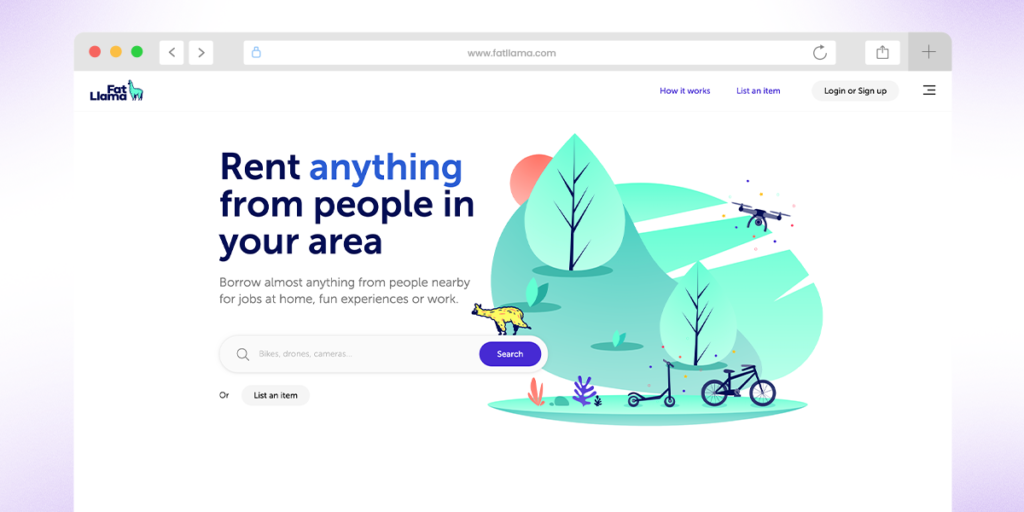
Pros and challenges of building a peer to peer rental marketplace
In this section we take a look at some of the pros and challenges of building a peer to peer rental marketplace.
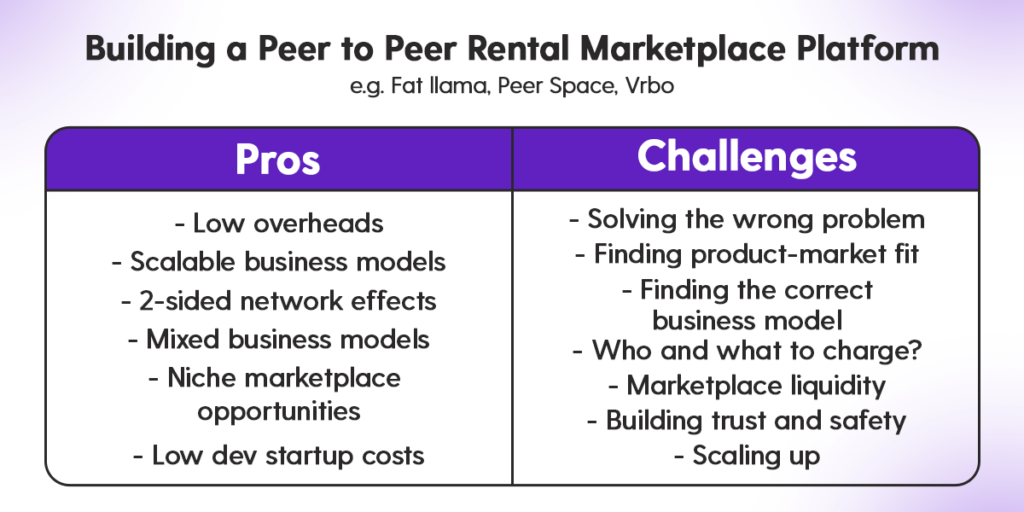
Pros of building a peer to peer rental marketplace
There are several benefits to building a peer to peer rental marketplace. In this section we break down what these benefits are.
Low overheads (no inventory needed)
A major advantage when it comes to building a peer to peer rental marketplace is that they are relatively low cost to set up and run.
In most industries startups need to invest in and maintain inventory to rent out to customers. In contrast, p2p rental marketplaces do not need to purchase or maintain inventory listed on their marketplace. Instead, property providers do this for them.
Consider the peer to peer rental marketplace Turo, for example. In 2023, Turo had more than 350,000 active vehicle listings on their marketplace. Turo used these listings to generate more than $850 million in revenue however, Turo does not own a single car. The p2p rental marketplace is made up entirely of individuals who own spare cars and are responsible for their own vehicles and expenses.
If you want to build a peer to peer rental marketplace like Turo, you can use a specialist marketplace technology like Dittofi, that will help you spin up an enterprise grade rental marketplace in a couple of days and jump straight into selling.
Scalable business model
Peer to peer rental marketplaces have highly scalable business models. We’ve already seen in the previous section that Turo generated more than $850 million in revenue in 2023 without owning a single car. Other mainstream and niche rental marketplaces perform equally well. For instance while mainstream platforms like Airbnb generated more than $9 billion in revenue in 2023, niche players like GlampingHub generated more than $5 million in revenue for the same period.
But how can you scale your p2p rental marketplace revenue?
The truth is that there are a lot of factors that go into scaling your rental marketplace revenue such as product development, contracts, customer acquisition and so on. However, at the heart of every rental marketplace business is a highly scalable business model. These business models include commission based, lead fee, listing fee and so on.
The most common business model for rental marketplace is the commission model. This is when the rental marketplace charges a small commission fee for transacting on the marketplace. For example, let’s assume that we have a p2p rental marketplace that allows property providers to list equipment and renters to join the marketplace to rent out that equipment for a fee. The marketplace will subtract a percentage of the fee for instance 20% of the fee from the providers and renters on the marketplace. The image below clarifies how this transaction works.
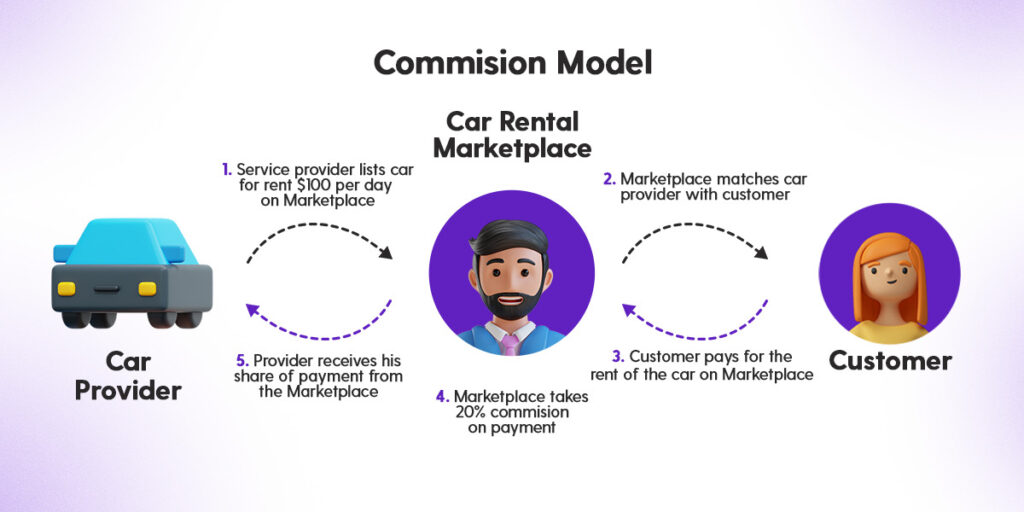
If the total rental price is $100 for the equipment, the marketplace will generate $20 revenue for themselves. Now the marketplace only needs to focus on increasing the number of transactions on the marketplace and the revenue will scale up with them. Imagine that you go from renting one property per day, to renting 1000 properties per day. Now your marketplace revenue is $20,000. This might seem far-fetched. However, as we are about to see, scaling up the revenue can happen very fast because of something called two-sided marketplace network effects.
Two sided marketplace network effects
Network effects describe the situation where the value of a product or service rises with the number of people using it. The classic example is the telephone. When there is only one telephone in the world, the telephone holds no value because there is no one to call. However, as more people start to use telephones, the value of the telephone will increase exponentially. In short, the more people who use the telephone leads to a direct increase in the value of the telephone to its users.
There are many different types of network effects such as direct network effects, two-sided network effects and social network effects. Peer to peer rental marketplaces benefit from two-sided network effects. These are a special type of network effect where the are two sets of users. First the supply-side (property providers) who display their property and second, the demand-side (renters) who are there to rent out the property. These different users provide direct value to each other through the marketplace.
Think of the analogy of a garage sale. With just one person hosting a garage sale, there are few items available and the platform is unlikely to attract many buyers. However, the more individuals who join as sellers, the offering and variety of goods increases. This attracts a wider range of buyers and then because there are more buyers, this attracts more sellers. This is the two-sided marketplace network effect and it can quickly snowball into a busy marketplace with lots of transactions happening all at once.
With a two-sided marketplace, the network is what provides the value rather than the app or website itself. This is why rental marketplaces like Airbnb or Vrbo can afford to look essentially unchanged after 10+ years. That being said, you need to pick a marketplace technology that can handle scale efficiently, as your marketplace grows in usage.
Mixed business models
As we have just seen, peer to peer rental marketplaces can enjoy two-sided marketplace network effects. These network effects help to accelerate growth with every new user. As communities of people come together to transact on the marketplace, rental marketplaces are able to drive more revenue and differentiate themselves from the competition by implementing mixed business models.
To see an example of this, let’s consider the p2p rental marketplace Vrbo which competes with Airbnb. Whilst Airbnb charges a flexible commission fee of between 3% – 14% commission. In contrast to this, Vrbo offers two pricing models: an annual subscription fee for hosts and a pay-per-booking model. The annual subscription fee allows Vrbo to lock in an annual recurring revenue of $499 for hosts whereas the pay-per-booking is a commission of 5% on the booking plus a 3% payment processing fee. The optional subscription models can give hosts the incentive to sign up for 12 months if they expect to rent out their properties more frequently.
Note: when choosing a business model for version 1 of your rental marketplace, it’s best to keep things simple and layer in different business models over time.
Niche marketplace opportunities
A niche peer to peer rental marketplace is one that connects specialized property owners with their ideal customer.
For example, marketplaces like Airbnb are so large that it can be hard to find specialized short term accommodation such as camping sites, treehouses, yurts, houseboats or even just family friendly accommodation. Niche rental marketplaces such as GlampingHub, Boatsetter and Kid & Co all provide opportunities for rental marketplaces to connect owners of these niche vacation rentals with their ideal customer audience. Each of these platforms turn over millions of dollars in annual revenue, simply by focusing on their target niche. If you can find a niche p2p rental marketplace this can allow you to quickly build a successful marketplace. Below is a list of niche peer to peer rental marketplaces examples for some inspiration.
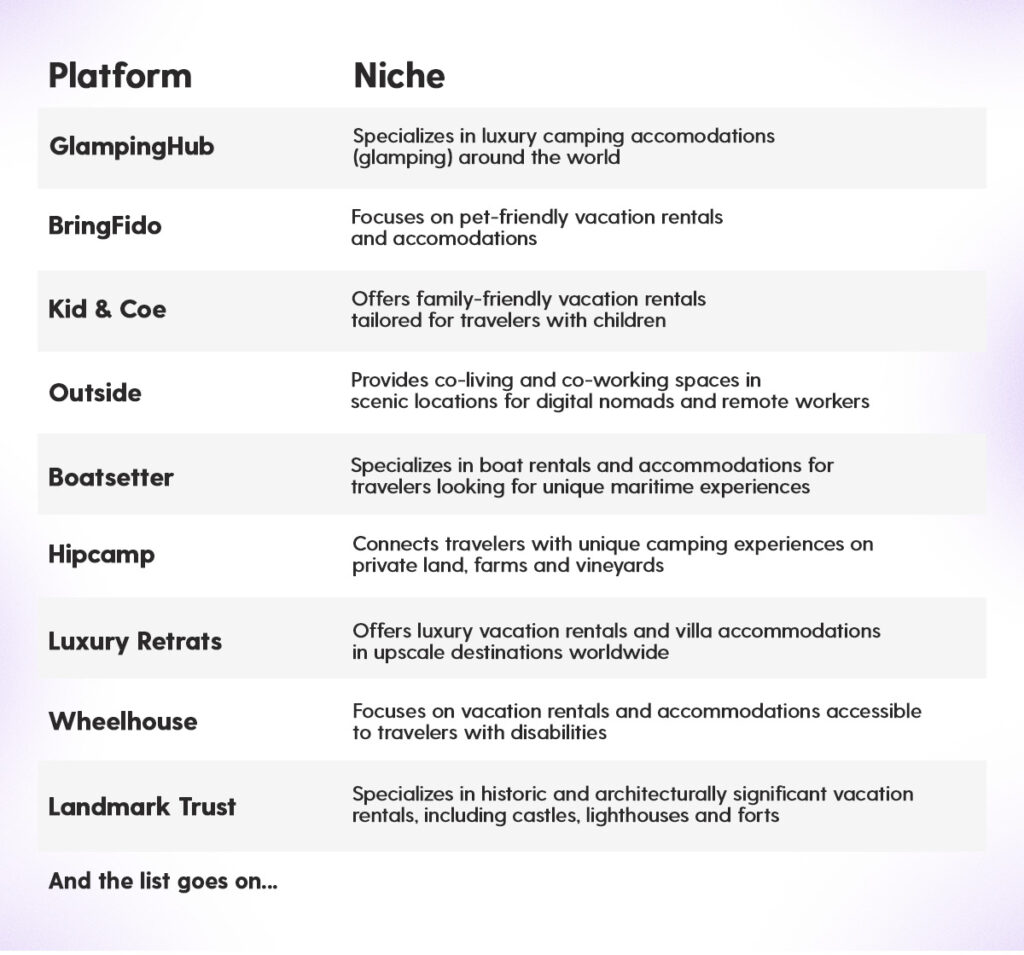
Low dev startup costs
Five years ago developing a peer to peer rental marketplace website like Airbnb, Turo or Fat Llama would have cost you north of $50,000 just to get started.
Since then, there has been a monumental improvement in software development tools and methodologies such that you can now build enterprise grade p2p rental marketplace for less than $50. This can be done using specialist marketplace technologies of which there are plenty of options to choose from. You should be careful how you choose your marketplace technology however since a bad choice of technology can result in high dev costs, slow time to market and make it hard to expensive to run and customize your solution over time.
We recommend using a hybrid no-code solution that is specialized in marketplace technology such as Dittofi. These platforms allow you to build and launch your peer to peer rental marketplaces in less than a day, onboard your first users and then to rapidly iterate without coding and 10x faster than traditional coding.
Challenges of building a peer to peer rental marketplace
In addition to highlighting some of the major benefits of building a peer to peer rental marketplace, there are also some pretty major challenges. In the this section we take a look at what some of these challenges are and how to overcome them.
Solving the wrong problem
The number 1 reason that marketplaces fail is that they build too much technology too soon.
In the early stages of your marketplace development you should be focused on finding solutions to problems faced by target property owners and renters. Once you’ve identified a possible problem, you can build a quick solution to these problems and test if these solutions solve the problem. This process is called idea validation and you should aim to validate your idea as quickly as possible and, with the lowest possible cost.
For instance, when Airbnb started, they identified that property owners in San Francisco were struggling to pay high rents. At the same time, they realized that people visiting San Francisco were struggling to find affordable short term accommodation. They therefore focused on developing a solution to this problem which started out as a simple website where the Airbnb founders offered out their apartment to guests who could not find a local hotel room.
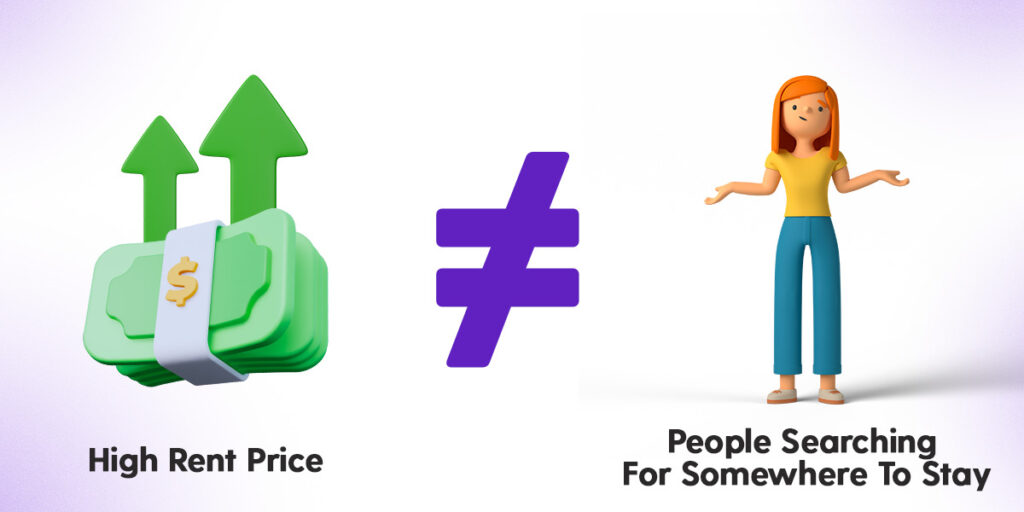
Another example is Turo, the rental marketplace for cars.
Turo realized that many car owners have vehicles that sit idle for extended periods. This leads to wasted resources where car owners must pay for vehicle upkeep, depreciating value, insurance and so on. Meanwhile there are plenty of people who need access to a caras for only a short period of time such as travellers who only need a vehicle for a short period of time.
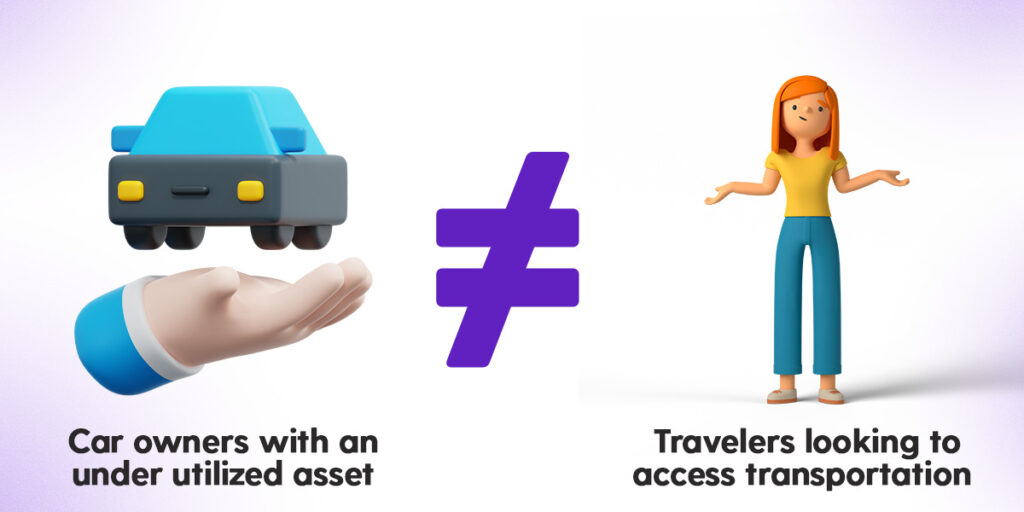
Once you’ve identified a problem and possible solution, you absolutely must validate that there is a real need for that solution before investing heavily in building a custom solution. In entrepreneurship this is known as idea validation. Once the problem and solution have been validated, this is called finding problem-solution fit. At this point you are now ready to start building a more custom marketplace solution.
Finding product-market fit
Once you have identified that there is a real world need for your rental marketplace, the next step is to customize your peer to peer rental marketplace for your target audience. This stage of marketplace development is called searching for product-market fit.
Product-market fit occurs when there is an alignment between your p2p rental marketplace solution and the needs and preferences of the specific market segment that you are targeting. Product-market fit is different from problem-solution fit. To explain this further, think about the following.
Imagine that you’re building a two-sided rental marketplace tailored for individuals seeking wedding venues. You match someone with available space to rent and someone in need of a wedding venue. Problem solved, right? Not quite. Despite the initial connection, numerous issues with the venue arise, leaving the customer dissatisfied and unlikely to recommend your service. In this scenario, you haven’t achieved product-market fit. In this context, product-market fit occurs when individuals are matched with available spaces that meet their expectations, leading to positive experiences, recommendations and repeat transactions.
Finding product-market fit is incredibly challenging. This is because it requires a huge amount of customization to your marketplace. This can be expensive, especially if you’re developing you rental marketplace with custom code. Conversely, if you build a marketplace with traditional no-code platforms, these can be heavily limiting which can prevent you from finding product-market fit.
In contrast, Dittofi has developed a specialist hybrid no-code marketplace technology that allows you to build a peer to peer rental marketplace within 24 hours and then customize it 10x faster than coding but with the same flexibility as custom code. Dittofi’s unique hybrid approach combines the best of visual development and traditional code allowing you full control over your marketplace source code as you scale.
Finding the correct business model
There are eight primary marketplace business models that are used by peer to peer rental marketplaces these are:
- Commission model
- Subscription revenue model
- Listing fee revenue model
- Lead fee model
- Freemium model
- Ads and featured listings model
- Data licencing model
- Mixed revenue model
The most popular of these models is the commission model.
As we have already seen, peer to peer rental marketplace that use the commission model charge a percentage commission, also known as the take rate, rake or transaction fee, when connecting property providers with renters.
The commission model is especially popular because neither the property provider or the renter are charged to join the platform. This can help reduce friction of joining the marketplace and help drive initial user adoption.
Who and what to charge?
When implementing the commission model for your p2p rental marketplace you need to decide who you are going to charge the fee to and how much commission you will charge.
Who to charge
The commission fee can be charged to either the property provider, the renter or to both. But how can you decide who to charge and what amount to charge?
One way to look at this is that the primary purpose of a p2p rental marketplace is to facilitate transactions between providers and renters. To achieve this, you need to build a frictionless transaction flow. High rakes (commissions) are a form of friction. Therefore, you want to charge the commission on the side of the market where you are least constrained. For instance, if you are constrained on the property provider side, you should charge the commission on the renter side whereas if you are constrained on the renter side, you should charge the commission on the provider side.
Another way to go is by considering the performance of similar marketplaces in your sector. For example, in the p2p rental marketplaces in the short term vacation rental space e.g. Airbnb, Vrbo, GlampingHub etc. each charge the property providers the commission and not the renters. Furthermore, it has been proven that the inclusion of cleaning service fees on these properties is best included in the overall price of the property listing, rather than being added on at the checkout stage. This was demonstrated by comparing the Vrbo transaction flow vs Airbnbs.
How much to charge
When it comes to vacation peer to peer rental marketplaces there is no one size fits all approach to pricing. The rate that you can charge ultimately boils down to your target market. This is because all markets have different levels of competition, marginal costs, demand and supply dynamics, network effects and transaction volumes. For example, let’s suppose your p2p rental marketplace operates in a highly competitive market, this can make it difficult to charge high commissions.
Choosing the correct business model: Final thoughts
To find the correct business model for a p2p rental marketplace, you need to test your marketplace and see what users are willing to pay.
You should certainly charge something for users to transact on your marketplace however, it is only through a process of experimenting and iterating that you are going to find a model that works for your users.
Most mature marketplaces use a mixed model, whereby they combine multiple business models together in order reward high volume and loyal marketplace users with lower fees or by building ancillary tools that allow the marketplace to charge a commission.
Marketplace liquidity (the chicken and egg problem)
Liquidity is the lifeblood of rental marketplaces. It refers to the efficiency with which a marketplace matches property providers and renters on its platform. Given that a marketplace with no liquidity has zero transactions taking place, it’s fair to say that liquidity IS the marketplace.
To achieve good marketplace liquidity, you need to carefully balance the number of active property providers and renters on your platform. However, getting your marketplace going in the first place can be tricky, due to the marketplace chicken and egg problem. This refers to the challenge of having no property owners on your site. When there are no property owners, there is little incentive for renters to come to your marketplace. In the same way, when there are no renters, there is little incentive for the property owners to list their properties.
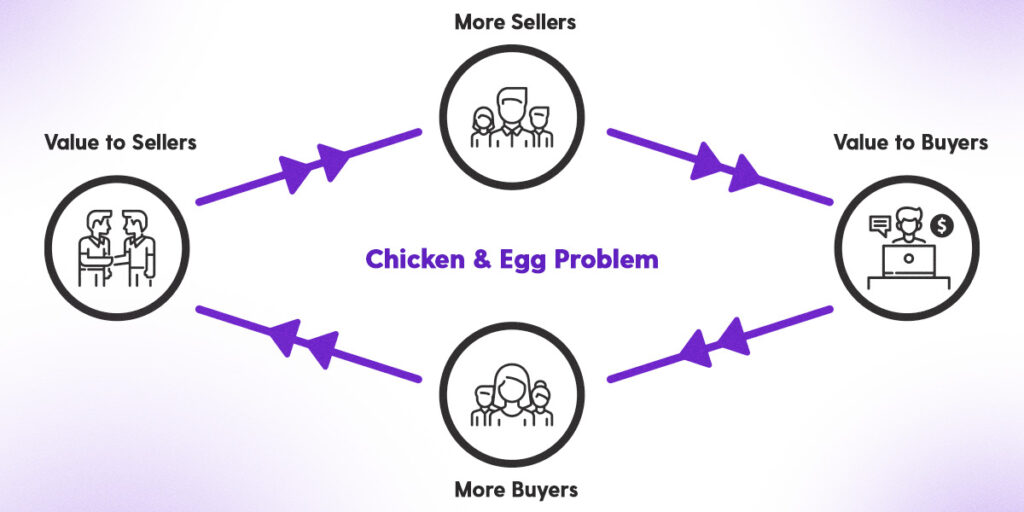
There are various strategies to overcome the marketplace chicken and egg problem and to maintain good marketplace liquidity. Some of these strategies are shown below.
For the most part however, you need to find a sustainable way to ensure that you’re onboarding a steady stream of property providers and renters to your marketplace. Once converted to paying users, you will then need to deploy customer activation and retention strategies.
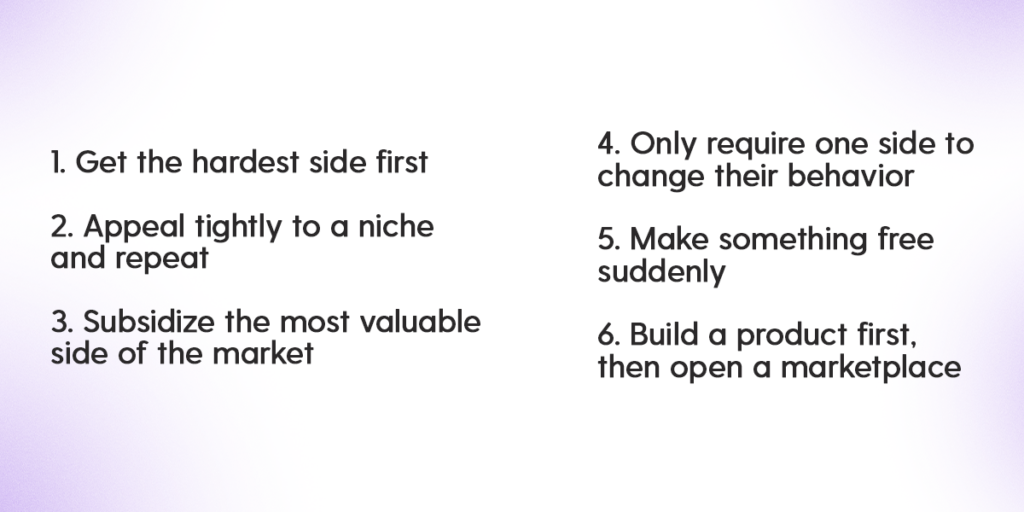
For the most part however, you need to find a sustainable way to ensure that you’re onboarding a steady stream of property providers and renters to your marketplace. Once converted to paying users, you will then need to deploy customer activation and retention strategies.
Building trust and safety into your marketplace
Before Airbnb became the trusted marketplace, can you imagine allowing complete strangers to spend the night in your home or, travelling to a remote location and sleeping in a random person’s house? Nowadays almost all of us are willing to book short term rentals from complete strangers over the internet, just by quickly checking the star review on the Airbnb website.
Although this works for p2p rental marketplaces like Airbnb, new marketplaces do not have the features, processes, brand recognition or reputation to make new users feel as secure as Airbnb. For new marketplaces, they must earn this reputation. This can be a challenge however, there are some features that marketplaces can put in place in order to achieve this. For example, you might decided to build passport verification into your system for new users, implement a double blind review system, take deposits, build a disputes resolution system and so on.
Of course, these features are only one aspect of building a trusted p2p rental marketplace system. Building your brand and reputation needs to be earned and this takes time.
Scaling up
Getting your first $10,000 of revenue on your p2p rental marketplace is only the first step in building a successful rental marketplace. Once you’ve built your marketplace, found problem-solution and product-market fit, the next step is to pour resources onto your marketplace to grow. This process is known as scaling up. However, you need to pick the right moment to scale since, if you have problems with your marketplace on a small scale, these problems will simply be magnified on a larger scale. Similarly, if you stay small for too long, you risk losing market share to competitors.
Reid Hoffman, founder of linkedin, writes that scaling is the process by which a company “prioritizes speed over efficiency, in an environment of uncertainty”.
This essentially means that you need to make decisions over when you’re going to prioritize doing something before fully understanding the implications of your decision. Airbnb demonstrated this mentality in one of the key decisions that they made which was to expand into new markets before entirely understanding the regulation in each new market. This “growth at any cost” allowed Airbnb to quickly expand its user base and reach, however they received numerous fines in the process. For example, the city of Barcelona fined Airbnb €30,000 for advertising unlicensed tourist apartments. The city considered these listings to be illegal under local regulations.
Essential features of a peer to peer rental marketplace
Peer to peer rental marketplaces are one type of marketplace solution.
There are three main categories of marketplace: B2B, B2C and C2C (or peer to peer) marketplaces. Inside each of these categories, there are three subcategories which are product, service and rental marketplace.
The different types of marketplace are shown below with examples.
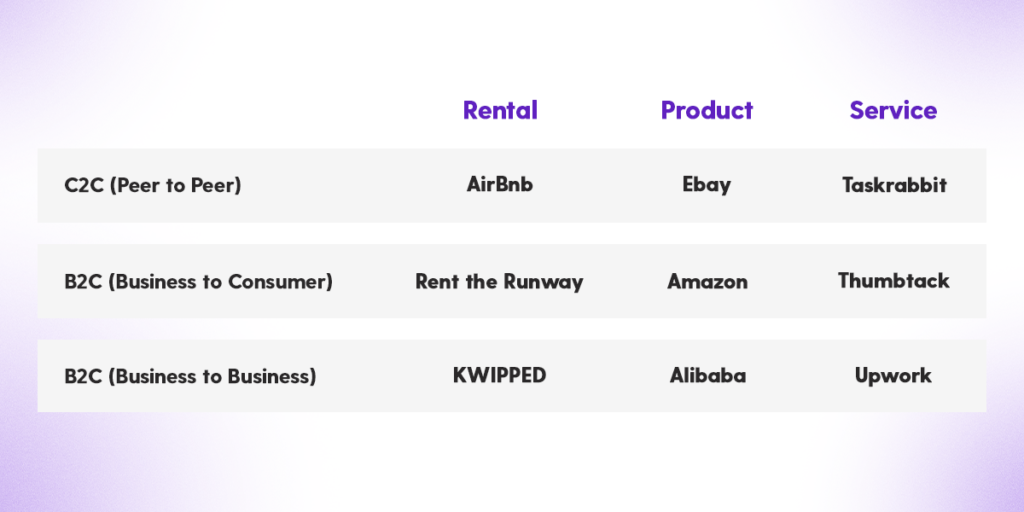
All marketplaces will have broadly the same sets of essential features. These include features such as listings pages, listing details pages, buyer and seller onboarding forms, payments and so on.
That being said, peer to peer rental marketplaces prioritize a slightly different set of features when compared to say product and service marketplaces. These include the following.
Availability calendars
An availability calendar refers to a tool or system that rental platforms must offer to their property providers. The calendar is used to keep track of and display the occupancy status of a rental property for specific dates.
The availability calendar is a critical component for any p2p rental marketplace since it allows property owners to keep track of the availability of their property. The calendar, typically a digital interface, is updated continuously as bookings are made or canceled, ensuring its reflection of the property’s status is as accurate as possible at any given moment.
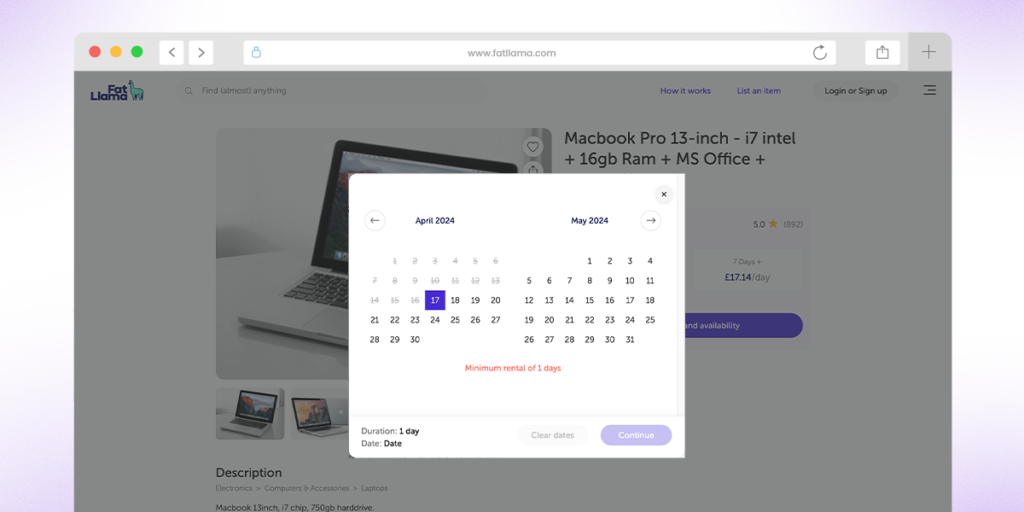
Item condition tracking
Rental inventory management is a systematic process that all property owners should take.
P2p rental marketplaces should encourage every property owner to catalog every bit of property within their listed inventory. Property owners should also be encouraged to carry out regular inspections of the property to review any breakages or damage and to assess the property condition before renting out the property.
Meanwhile the platform itself should offer space for each item to be listed with its features, current condition, and rental status. This provides transparency to the renters as to the condition of the property that they plan to rent.
Security deposits
Some p2p rental marketplaces choose to take security deposits. These can be held until the transaction flow has been completed. The purpose of the security deposit is to serve as a means to fix or replace something in a rental unit that was damaged, lost, or stolen by the renter.
Most rental marketplace platforms do not use security deposits. Instead they offer custom insurance policies for property rented on their platforms.
Rental duration options
In contrast to product or service marketplaces, peer-to-peer rental platforms enable renters to lease property for a designated timeframe. Property owners should have the flexibility to determine the rental duration that suits their preferences. Offering various rental durations can distinguish a rental marketplace from its competitors. This distinction is particularly evident in how different p2p car rental platforms set themselves apart as Turo competitors.
Insurance options
Nightmare scenarios aren’t unheard for peer to peer rental marketplaces. There have already been high-profile cases of Airbnb landlords finding their homes trashed and Uber drivers being involved in cases of serious misconduct. For smaller platforms that don’t have insurance, damages that cannot be recovered can lead to a total breakdown in provider trust that is impossible to recover from.
P2p rental marketplaces therefore need to carefully consider their responsibilities to providers and renters.
Item listings and usage guidelines
Peer to peer rental marketplaces should all include item listings and guidance around how the items can be used.
How to build a successful peer to peer rental marketplace
Even though the technological barriers to building a successful peer to peer rental marketplace have been reduced significantly, there are still some major challenges in building a successful peer to peer rental marketplace.
Whilst there is no exact formula for success, we recommend that you take the following steps.
- Find a p2p rental marketplace idea
- Validate your idea
- Choose your tech stack
- Build and launch your MVP
- Onboard early adopters
- Learn and grow
Let’s do a quick rundown of what is involved in each of these steps. For more information on each of these steps read, how to build a rental marketplace. Fast.
Step 1. Find a peer to peer rental marketplace idea
Great peer to peer rental marketplaces start with idea to solve a real world problem for providers and renters.
We’ve already seen how the car sharing platform Turo solved problems faced by car owners and individuals by connecting car owners with individuals looking to rent out their cars. We’ve also seen how Fat Llama helped property owners monetize their belongings by allowing them to rent out items to others in their local area.
Each of these examples demonstrates how a p2p rental marketplace can provide practical solutions to problems faced by property owners and individual consumers.
There are various ways to come up with an idea for a new peer to peer rental marketplace, we cover some of these methods in our article How to come up with a great idea for an online marketplace.
If you already have an idea for a p2p rental marketplace, take care to note that it is often best to consider a niche marketplace first. Amazon is perhaps the best example of a marketplace (although a B2C product marketplace) that demonstrated this mentality. Although Amazon’s founder Jeff Bezos had a vision to be the “marketplace for everything”, they first started out by taking a very small slice of the market, focusing only on books.
Paul Graham, co-founder of the startup accelerator Y Combinator, also emphasizes the importance of focusing on a narrow target market. As he explains, the focus allows you to deeply understand the needs of customers within that target market and therefore build a good solution to their problem.
Marketing to a narrow audience is also significantly less resource intensive than trying to capture the entire market at once. For instance, focusing on one target audience means you only need to build one marketing strategy. Conversely, if you focus your marketing efforts on several possible target audiences, you need a plan that will focus on all the different channels simultaneously. You will then also need to create specialized content for each channel that targets each user group with a different set of language which is more focused.
Step 2. Validate your p2p rental marketplace idea
Once you have a great idea for a peer to peer rental marketplace, the next step is to validate that there is a market for your idea. You should do this before investing too much time or energy into the development of your marketplace.
Idea validation essentially involves finding target users and gathering evidence that proves there is a genuine market demand for your marketplace. There are five steps that founders normally take to validate their marketplace idea. These are listed below.
- Test any risky assumptions that you’re making about your market
- Assess your market size and share
- Research search volumes for related keywords
- Conduct customer validation interviews
- Build the first version of your marketplace
It’s very important to validate your marketplace idea, but also not to spend too much time only validating your marketplace idea. There is such an opportunity cost to not starting your marketplace development. Therefore, we recommend writing out a list of practical steps that you will take to validate your idea and then setting a budget and a time based deadline for yourself to complete your idea validation.
We cover what is involved in each of these steps in our article on how to validate your marketplace business idea.
It’s very important to validate your marketplace idea, but also not to spend too much time only validating your marketplace idea. There is such an opportunity cost to not starting your marketplace development. Therefore, we recommend writing out a list of practical steps that you will take to validate your idea and then setting a budget and a time based deadline for yourself to complete your idea validation.
Step 3. Choose your p2p rental marketplace tech stack
The next step is to choose the tech stack to build your peer to peer rental marketplace on.
There are three main technologies that you can use to build a peer to peer rental marketplace.
You can use:
- Custom code, and build your marketplace from scratch
- Use a specialist marketplace technology
- Use traditional no-code platforms.
Each of these options has some pros and cons that we will take a quick look at now.
Custom code, pros and cons for p2p rental marketplaces
In this section we take a look at the pros and cons of custom p2p rental marketplace development.
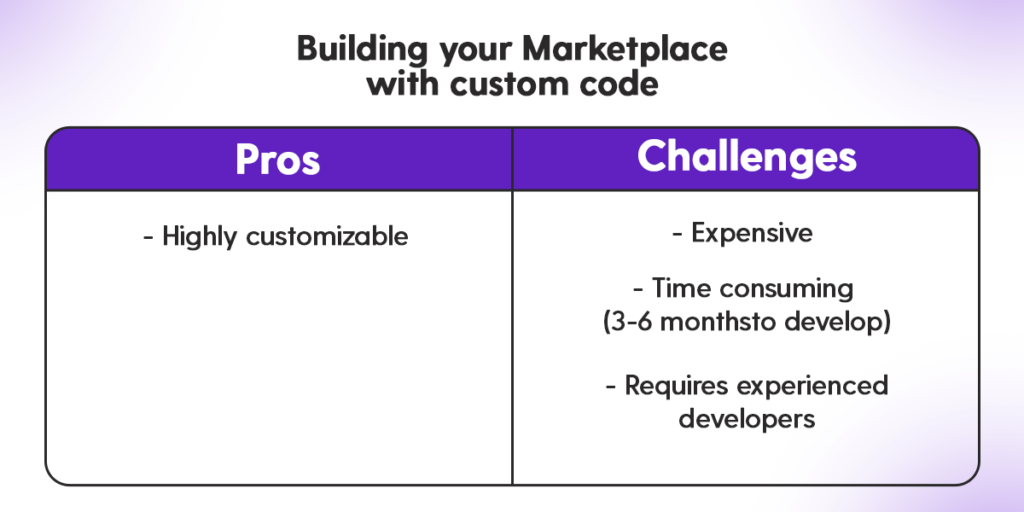
The big advantage to using custom code to develop your peer to peer rental marketplace is that you will be able to customize it as much as you want. However, there are a lot of cons. First, it is very expensive to build a p2p rental marketplace from scratch i.e. somewhere between $50,000 – $250,000 of investment. It’s also very time consuming, you should expect to take anywhere from 3 – 6 months to build version 1 of your marketplace from scratch. Finally, it requires a team of highly experienced marketplace developers.
The challenges with custom code far outweigh the positives, especially when you consider there are open source marketplace solutions that you can use to build a p2p rental marketplace solution. As we shall see, the open source marketplaces solutions are specialist prebuilt marketplace solutions that you can simply take, use and own. So, if there are open source p2p marketplace solutions, why then would you code from scratch? It really doesn’t make any sense to spend time and money building something that already exists.
Pros and cons of specialist marketplace technology
Specialist marketplace technologies are essentially prebuilt marketplace solutions. There are three main types of marketplace technology. These are:
- Open source marketplace technology
- Software as a Service marketplace technology
- Hybrid no-code marketplace technology
Each of these solutions have their own pros and cons, which we list out below.
Open source marketplace technology
Open source marketplace technologies are those that allow you to take the code for a prebuilt marketplace and customize it according to your needs.
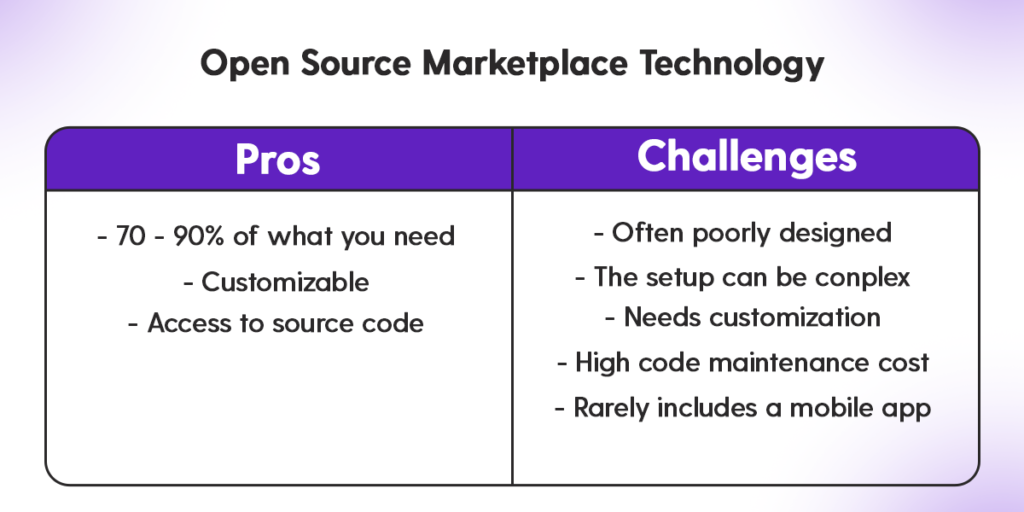
The advantages of open source solutions are that these platforms contain roughly 70% – 90% of the features that you need for your marketplace development. Next, since you have access to the source code, these solutions are customizable to your needs.
The negatives to open source marketplace solutions are that these platforms are often poorly designed. This is because the majority of these platforms were originally developed for traditional single sided ecommerce stores. Next, the setup cost for these is high because the platforms require you to hire engineers to work with code which, as we saw in the previous section, is expensive and time consuming. Finally, you will need to customise these solutions to truly get the solution that you are looking for and the cost of maintaining the solutions in the long run is high.
From our experience, developing a marketplace using an open source solution is definitely faster than coding from scratch however, you’re still looking at 3 months of custom development to make them work for version 1 of your marketplace. You then need to factor in the maintenance cost over time.
SaaS marketplace technology
The second type of specialist marketplace technology is a marketplace SaaS platform. The pros and cons of these solutions are listed below.
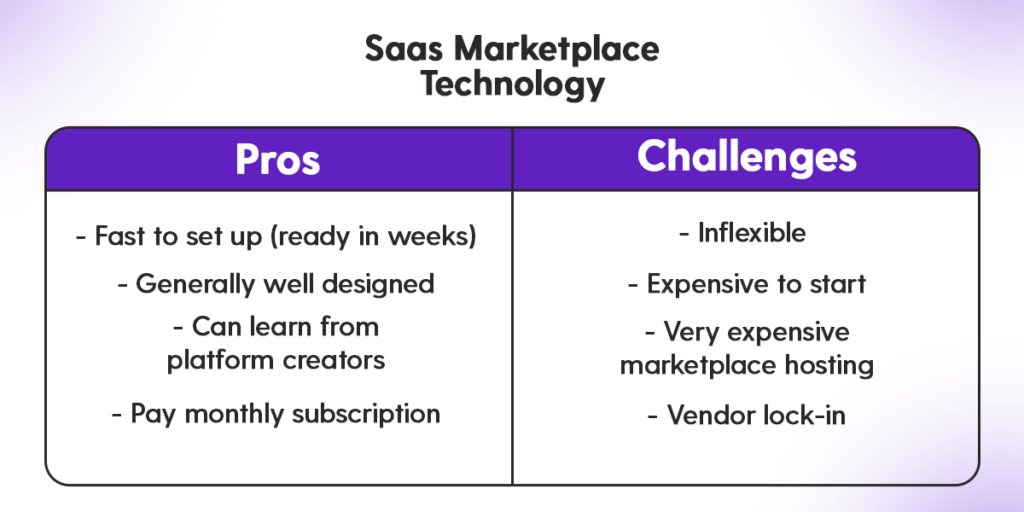
Pros of these solutions are that they are fast to set up, you can be ready in weeks. They are generally speaking well designed and, you can learn from the platform creators who have a vested interest in seeing your marketplace succeed. Finally, you benefit from being able to pay a monthly subscription that you can cancel at any time.
The downside to these solutions are that they are highly inflexible, making it impossible to build a truly custom marketplace. They are expensive to start and, as you grow, the marketplace hosting can become cost prohibitive in the long run. Lastly, you risk vendor lock-in since these platforms do not allow you to own your marketplace source code and IP.
In conclusion, these solutions are good for testing the waters however in the long run you would be better off choosing a newer hybrid no-code marketplace technology, as we are about to see.
Hybrid no-code marketplace technology
The third type of marketplace technology is a hybrid no-code platform. These solutions are the newest ones on our list designed to combine the best of open source marketplace solutions with SaaS marketplace technology.
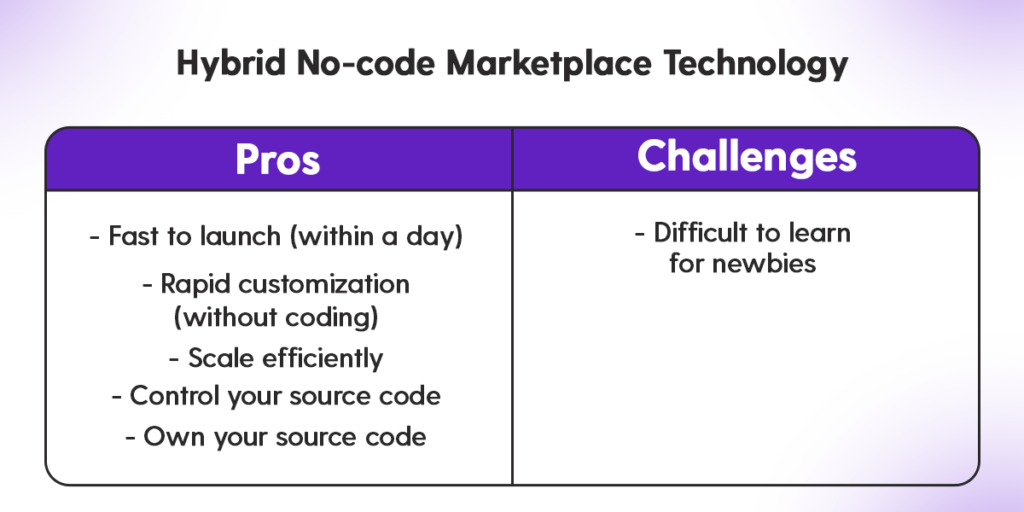
Hybrid no-code solutions uniquely combine the best of SaaS marketplace technologies with open source solutions. These platforms allow you to quickly and easily build a p2p rental marketplace in as little as 24 hours. This is version 1 of your marketplace and can be used to quickly and easily find product-solution fit. You are then able to rapidly customize your marketplace using hybrid no-code until you find product-market fit. You can do this without coding and 10x faster and lower cost than using custom code or open source marketplace technologies. Finally, unlike traditional no-code platforms or SaaS marketplace technologies, hybrid no-code platforms allow you to own your marketplace source code and IP.
The challenges with hybrid no-code marketplace technologies is that they can be difficult to learn for newbies. However, they use real programming concepts, so learning time is certainly not wasted. Dittofi is the original hybrid no-code marketplace platform and we would certainly recommend that you check out this technology as part of a free trial.
Pros and cons of traditional no-code solutions
Traditional no-code platforms such as Bubble.io are the worst way to go when it comes to marketplace development. In this section we will take a look at why we think that this is the case.
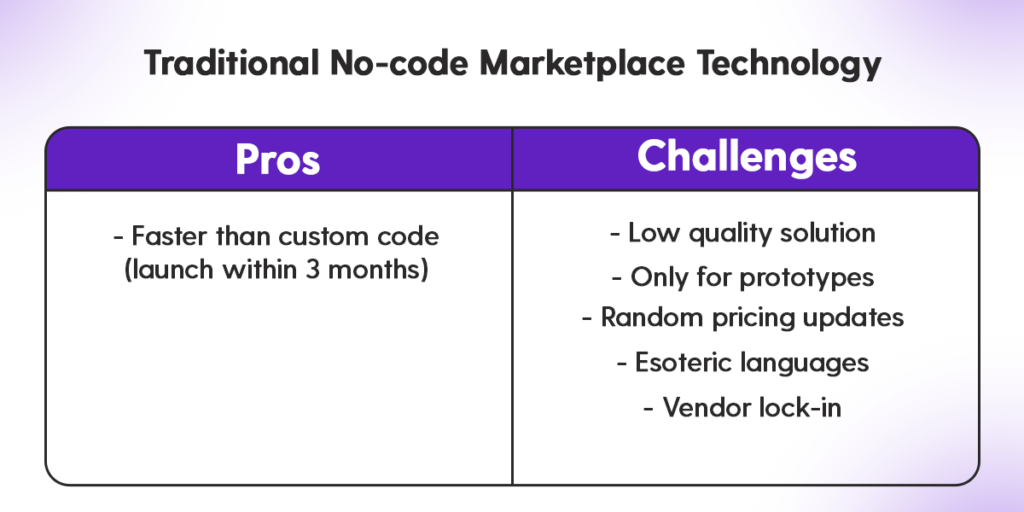
Traditional no-code platforms generate low quality non-scalable marketplace solutions. Whilst it is true that these platforms allow you to build faster than custom code, they come with plenty of challenges such as, vendor lock-in, random pricing updates and the fact that they all have their own esoteric visual coding languages.
Since it takes so much time to learn, many people avoid using these platforms directly and instead invest in hiring a no-code marketplace developer. This is totally a waste of money – why would you hire someone to build a no-code marketplace that you don’t even own when there are options like open source or hybrid no-code marketplace solutions.
We absolutely do not recommend using traditional no-code solutions to build your marketplace. These platforms are really only popular because of the huge amount of investment they’ve had over the last 10 years. This investment capital has allowed them to invest in developing networks of unscrupulous resellers who recommend their products in exchange for kickbacks.
Conclusion: How to choose your marketplace tech stack
It is very important to take the time to choose a quality marketplace tech stack. A good choice will live with you for the life of your marketplace. A poor choice will require you to rebuild your marketplace at some point. Having to switch technologies early on can be relatively painful however, having to do this down the line when you have active users can be fatal to your marketplace.
We recommend choosing an option where you have control over your marketplace source code. This is important because otherwise you will become dependent on another company for your marketplace technology. Meanwhile, for early stage marketplaces, we recommend that you choose a solution where you will not be entirely reliant on a marketplace developer since this will lead to high development and maintenance costs while you’re searching for product-market fit. As such, the best solution is a hybrid no-code platform.
Step 4. Build and launch your MVP
At this stage, you’ve found a problem and a solution, validated that there is a market demand for your idea and you’ve chosen a marketplace technology.
However, it is difficult to anticipate how people will use your marketplace. For instance, do property owners struggle to list their property? Is the process for onboarding new listings long and complex? Do listings pages enable renters to access all the critical information about a specific property?
To learn more about how your users actually use your peer to peer rental marketplace, the next step is to build your marketplace MVP.
To do this, you will need to use your choice of marketplace technology and use this to develop a somewhat lightweight rental marketplace. The main thing to be aware of here is that you need to lauch fast and then adjust your marketplace. based on customer feedback.
Fore more information on how to build your marketplace MVP, read how to build an online marketplace MVP fast.
Step 5. Onboard early adopters
Now that you have your marketplace MVP, the next step is to onboard early adopters.
With rental marketplaces this can be especially challenging since, without property providers showcasing their listings there is little incentive for renters to come to your platform. Similarly, without renters, property owners will not be able to make money by listing on your platform. This is known as the marketplace chicken and egg problem.
To solve this problem, you need to pick one side, either the provider or the renter and convince that side to sign up to your marketplace first. The rule of thumb is that it is best to start by getting to the hardest side of the marketplace first. This means that if property providers are the hardest side to get on, start by convincing property providers to list their properties. Meanwhile, if renters are harder to get interested, start by convincing renters to get on.
FIve times marketplace founder James Currier gives 19 tactics that you can use to solve the chicken and egg problem. These are listed out below.

For more tips on onboarding users, read how to solve the marketplace chicken and egg problem.
Step 6. Learn and grow
Now that you’ve recruited your early adopters to your peer to peer rental marketplace, the next step is to monitor closely how your property providers and renters behave inside your product.
You will then need to make changes to your marketplace based on customer feedback. For example, updating your property providers onboarding flows to collect less or more information, making adjustments to your marketplace categories, adding single sign features to remove friction at sign up. You should absolutely NOT make any changes to your marketplace based on your own ideas. Instead, you should communicate with your customers, ask them what they like and don’t like about your marketplace. You can then design solutions to improve the marketplace based on customer feedback.
In the learn and grow phase, you need to make adjustments to your marketplace as fast as possible. This will help to reduce customer churn and improve your new customer experience. It can take a long time to get to profitability in your marketplace, so there are important marketplace metrics you can use in order to check that you’re making good decisions.
For more tips read, what are the top marketplace metrics to track.
How much does it cost to build a peer to peer rental marketplace?
As we have seen earlier in this article, the cost of building a peer to peer rental marketplace depends on the method used to build the marketplace.
In this section, we look at the cost of coding your marketplace from scratch vs using Dittofi’s hybrid no-code marketplace technology.
How much does it cost to build with custom code
If you hire a development agency to code your custom marketplace from scratch, this will cost anywhere from $50,000 – $250,000 for version 1 of your marketplace. The steps involved this process include:
- Product discovery: In this stage the development agency will scope out exactly how you want your marketplace to work.
- Product design: Once the agency has a good idea of how you envision your marketplace working, the agency will then go away and design version 1 of your marketplace. The output of this work is a set of product wireframes that they will as a blueprint to start coding your marketplace.
- Implementation: In this stage the development agency will code your marketplace. This takes anywhere from 3 – 6 months, depending on the defined scope.
A cost breakdown of this is shown below. We also include the cost of the development of a custom marketplace hosing model and the cost of running your marketplace.
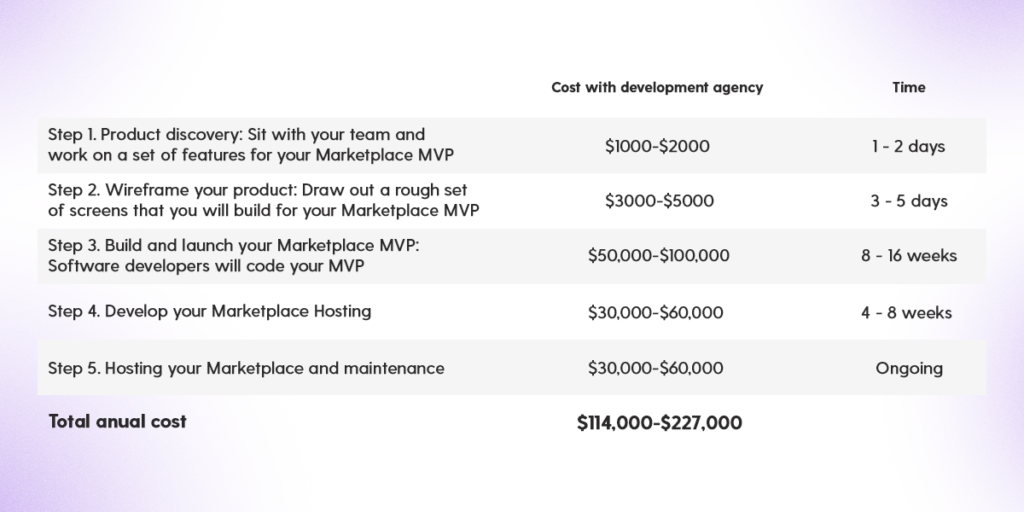
How much does it cost to build with hybrid no-code
Build your marketplace from scratch is entirely pointless since it involves rebuilding a set of features that have already been coded hundreds of times before. One such solution is Dittofi’s hybrid no-code platform, which gives you all of the marketplace essential features without having to write a ainsgle line of code. You can then either access the code and customize it further or rapidly add new features from within Dittofi’s visual development studio.
The cost of building a p2p rental marketplace with Dittofi is shown below. As you can see the cost of version 1 is significantly lower that working with custom code and since you have access to the code, the result is exactly the same.
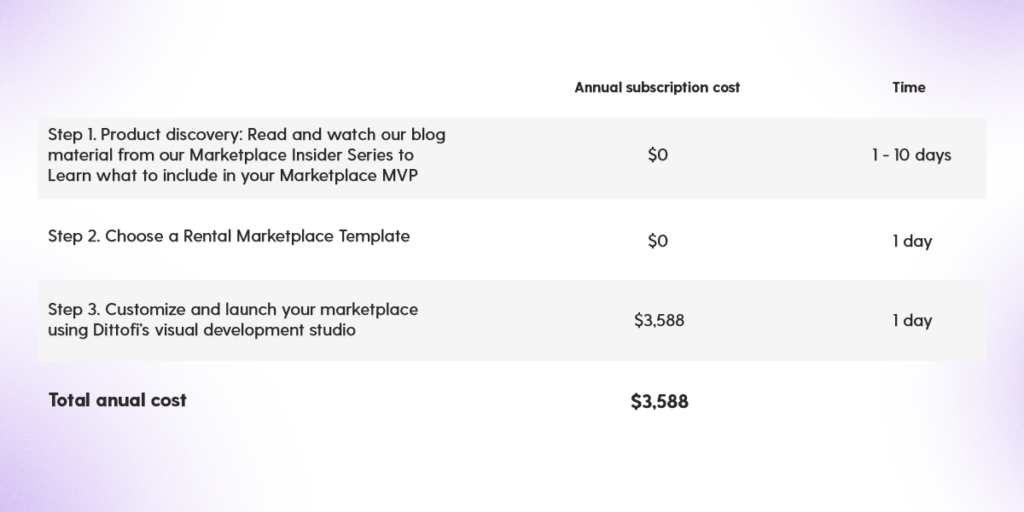
Dittofi’s peer to peer rental marketplace template
Dittofi has developed an open source, peer to peer rental marketplace template that you can use for your marketplace development. The platform includes all of the essential features that you need to build an enterprise grade rental marketplace.
You can configure this marketplace and launch in under 24 hours and without needing to hire a developer. From there you are able to start onboarding new users, get customer feedback and then incoprate customer feedback into your product quickly and easily using Dittofi’s visual development studio.
The screenshot below shows an example of Dittofi’s p2p rental marketplace template.
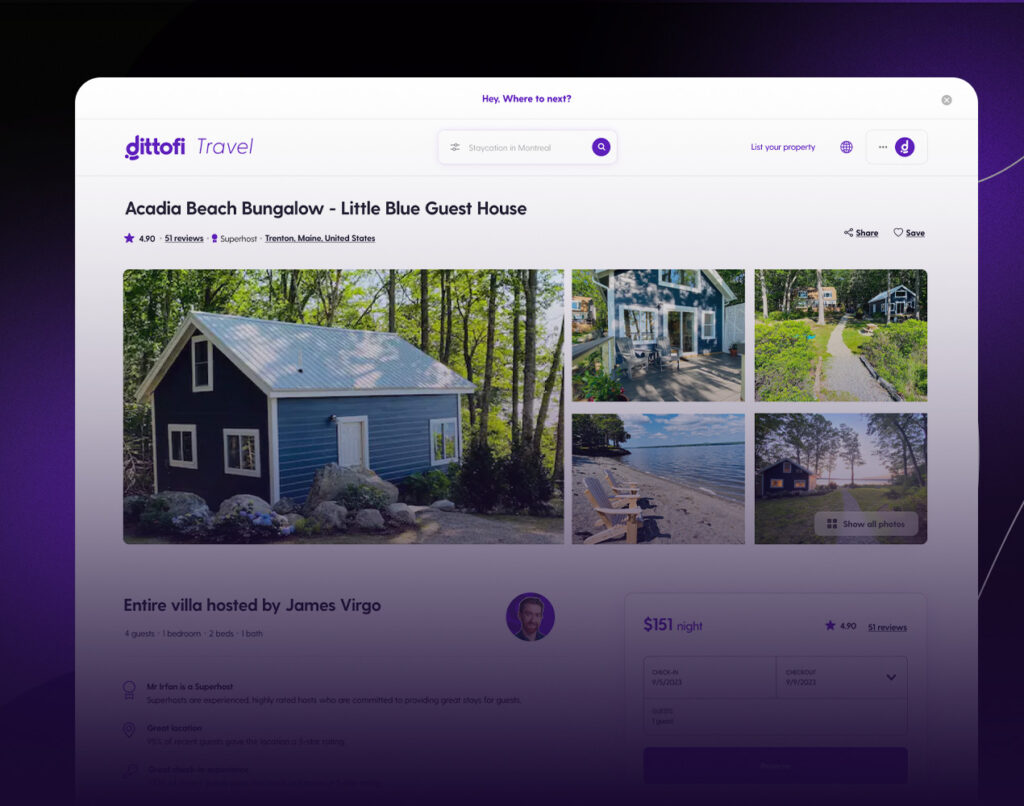
Conclusion: how to build a successful peer to peer rental marketplace business
Building a successful peer to peer rental marketplace business is incredibly challenging. There are a lot of steps that you must take in order to be successful.
That being said, the rewards for building a successful or even semi successful marketplace are huge.
If you would like to learn more about how to build a peer to peer rental marketplace, you schedule a call with one of our team or sign up to the Dittofi marketplace builder and try installing the marketplace under our free trial subscription.
Become a Marketplace Insider
Join our inner circle for exclusive insights, coveted trade secrets, and unparalleled strategies – your journey to marketplace dominance begins here.

